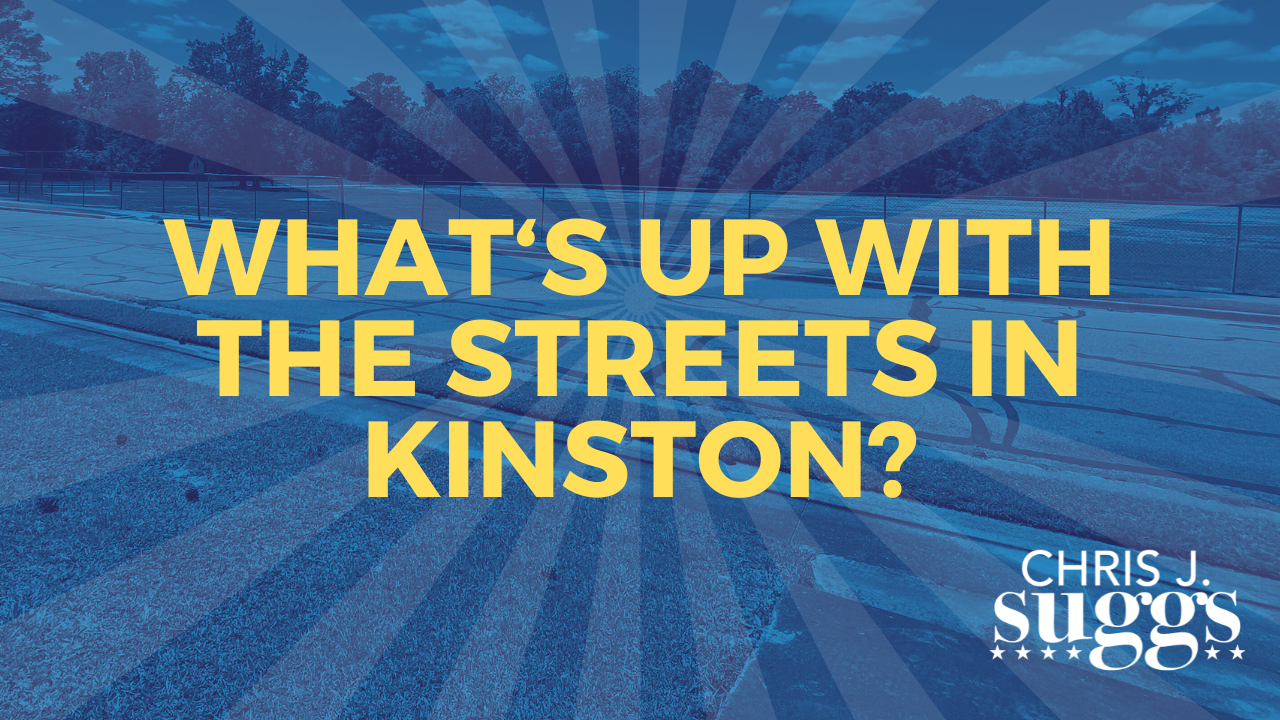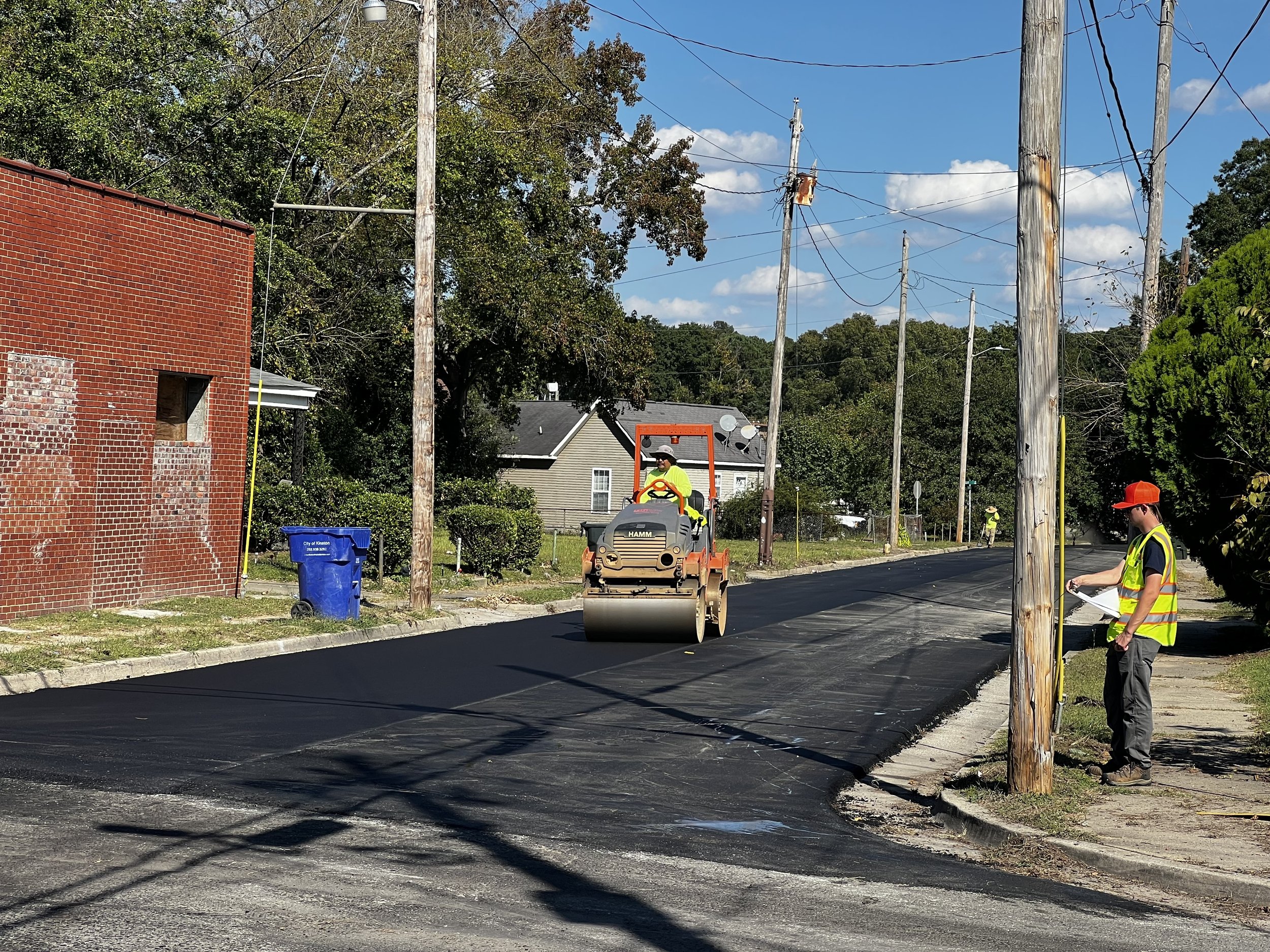What's up with the streets in Kinston?
They’re underfunded.
Streets can typically last 10-40 years; with the average lifespan of a street being around 25 years for low speed, local use streets. The lifespan of pavement depends on many factors, including traffic volume (especially the amount of truck traffic), speed, and the quality of materials used and workmanship.
There are over 115 miles of roads maintained by the City of Kinston in our City limits. To get to a 25 year lifespan on all of our streets, our Public Services staff estimate we need to resurface approximately 4.62 miles per year. The cost of that would be approximately $133,000 per mile of streets or $614,000 per year.
Kinston only budgets $250-300,000 for street resurfacing and road improvements per year. For the last several years, a significant portion of that amount has gone directly to reconstruct sections of Hardee Road.
A street resurfacing project on a section of Tower Hill Road in October 2022.
This year, there’s a potential for us to have approximately $588,000 allocated toward street resurfacing. The City budgeted $250,000 for street resurfacing for the 2022-2023 fiscal year but did not undertake any street resurfacing projects during that period while our staff completed a new street conditions survey (the last was completed in 2017). The City budgeted another $250,000 during this current fiscal year, and we have $88,000 leftover from previous street related projects. So, for the first time in a long time, our community will see a level of investment in our streets near what is professionally recommended.
During our January 16, 2024 city council work session, I asked my colleagues if we could 1) try to meet the $26,0000 gap between the $588,000 amount estimated for this year and the $614,000 amount professionally recommended; and 2) try to meet that $614,000 amount on an annual basis moving forward. Aside from one of my colleagues sharing some agreement, there was no other feedback in support of that.
If you’ve followed along in recent years, you know that this time of the year is when our city staff, City Manager, and City Council are engaged in discussions and planning to develop the city’s next operating budget. The new fiscal year for us will begin in July, so we typically work to have the budget completed by late May to early June to give our citizens an opportunity to review and comment on it before it is officially adopted. With the information shared in this post, I hope that our community’s citizens will consider reaching out to our city staff and their elected representatives on our City Council to ask that the City begin fully funding our city streets. If it is estimated that we need to allocate approximately $614,000 per year in order to keep up maintenance on our streets before they start to fail and we’re only allocating a fraction of that, we will continue to struggle with potholes and poor streets for years to come.
The response you might get from City leadership is that we can’t afford it—which, in my opinion, is only partially true. Yes, the City of Kinston is often on a tight budget and has to consider carefully how to fully fund all of our services and infrastructure needs while also making quality-of-life improvements for our citizens. However, there are some opportunities on the horizon that might provide us with a way to cover these costs.
Lenoir County is currently undergoing a reappraisal process to update property tax values in our community to reflect their current real estate market value, which is something the County is required by law to complete at least once every eight years. These reappraised values will become effective in 2025. It can be expected that, with the direction of the current real estate market, most of our homes and properties will increase in tax value compared to their current valuation—which is based on the county’s last reappraisal completed in January 2017. This means that if the City of Kinston keeps its property tax rate the same, at least for the fiscal year after the reappraisal is implemented, the City could potentially see an increase in property tax revenue and could direct some of those funds toward road improvements.
If you’ve been around for a while, you’re also aware that in the 1980s Kinston incurred a significant amount of debt from purchasing an ownership interest in nuclear power. The City (and in turn, its citizens and electric customers) have been responsible for paying off that debt and this is, in part, one of the reasons many customers believe Kinston has high electric rates. However, in 2015, Kinston (along with other cities like New Bern and Greenville) entered a 10-year agreement with the North Carolina Eastern Municipal Agency to reduce this electric debt significantly. Some people may recall that our electric rates slightly decreased that year. It’s my understanding that this debt should be fully resolved in the next two years, and at that point, we should be able to see even further relief in terms of our electric rates and/or potentially additional revenue that can go towards street resurfacing and other much needed improvements.
Lastly, President Joe Biden’s Bipartisan Infrastructure Deal, passed by Congress in November 2021, is leading to critical funding for road and infrastructure improvements being made available to communities like Kinston. It allocates $110 billion in funding to go towards repairing roads and bridges across the country, and our city staff and leadership have been working diligently to ensure that Kinston is included in those funding distributions. There are other federal funding opportunities, such as those included in the Inflation Reduction Act and American Rescue Plan, that the City is also eligible for or pursuing that could provide additional funds for road and quality-of-life improvements.
For work and leisure, I’ve driven all across our state and country, and have been in communities where their roads are far better or far worse than ours. Anecdotally, I would say that our road conditions are about average. But, that doesn’t take away from the fact that it is one of the most heard complaints that we receive from our citizens. If improving road conditions is something that our residents want the City of Kinston to make a priority, then your City Council has a responsibility to work towards making that a reality.
In addition to making improvements to the road conditions, we also need to explore ways to make our streets safer for vehicles, cyclists, and pedestrians—such as traffic calming measures, sidewalks, marked lanes and pedestrian crossings, as well as lighting. There are funding opportunities at the local, state, and federal levels—such as the opportunities I shared above, or other methods like general obligation bonds or strengthening how we collect fines and fees—that we can use to have more local revenue to get these important projects done. I believe that road conditions and safety are conversations that must go hand in hand, especially from a perspective of fiscal responsibility, and I look forward to sharing more about that in the future.
Yours in community,
Chris
Chris J. Suggs was elected to the Kinston City Council in November 2021 and is currently the youngest elected official in North Carolina. The Kinston City Council hosts its Regular Meetings on the first and third Tuesday of each month at 5:30PM and 7:00PM, respectively.
If you have any questions, concerns, or feedback, please don’t hesitate to reach out by email at chris.suggs@ci.kinston.nc.us or by leaving a message at the City Clerk’s Office (252) 939-3115.



